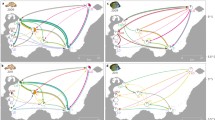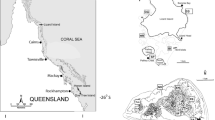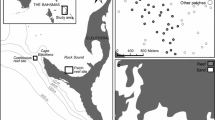Abstract
The two-phase life history of most marine fishes and invertebrates has enormous implications for dispersal, population connectivity, and resource management. Pelagic dispersal larvae of marine animals traditionally thought to ensure that populations are widespread, that chances of local extinction are low, and that marine protected areas (MPA) can easily function to replenish both their own populations and those of unprotected areas. Traditionally, dispersal is considered to depend primarily on two variables: pelagic larva duration and far-field currents. These conclusions arise from the ‘open population’ paradigm and are usually accompanied by a ‘simplifying assumption’: larvae are distributed passively by far-field currents. Unfortunately, they ignore the complex reality of circulation and hydrological connectivity of reefs, and do not consider newly-demonstrated behavioural capabilities of coral-reef fish larvae. Far-field circulation varies with depth and often excludes water bodies where propagules are released, and this has important implications for predicting trajectories of even passive larvae. However, larvae are not passive: late-stage larvae of coral-reef fishes can swim faster than currents for long periods, can probably detect reefs at some distance, and can actively find them. This behaviour is flexible, which greatly complicates modelling of larval fish trajectories. Populations at ecological (as opposed to evolutionary) scales are probably less open and more subdivided than previously assumed. All this means that dispersal predictions based solely on far-field water circulation are probably wrong. An emerging view of larval-fish dispersal is articulated that takes these new data and perspectives into account. This emerging view shows that re-evaluation of traditional views in several areas is required, including the contribution of larval-fish biology and dispersal to biodiversity patterns, the way reef fishes are managed, and the way in which MPA are thought to operate. At evolutionary and zoogeographic scales, reef-fish populations are best considered to be open.
Similar content being viewed by others
References cited
Armsworth, P.K., M.K. James & L. Bode. 2001. When to press on, wait or turn back: dispersal strategies for reef-fish larvae. Amer. Nat. 1157: 434–450.
Bellwood, D.R. 1997. Reef-fish biogeography: habitat associations, fossils and phylogenies. pp. 379–384. In: H.A. Lessios & I.G. Macintyre (ed.) Proceedings 8th International Coral Reef Symposium, Smithsonian Tropical Research Institute, Panama.
Benzie, J.A.H. 1999. Genetic structure of coral reef organisms: ghosts of dispersal past. Amer. Zool. 39: 131–145.
Benzie, J.A.H. & S.T. Williams. 1997. Gene flow among giant clam (Tridachna maxima) populations in the Pacific does not parallel ocean circulation. Evolution 51: 768–783.
Black, K.P., P.J. Moran & L.S. Hammond. 1991. Numerical models show coral reefs can be self-seeding. Mar. Ecol. Prog. Ser. 74: 1–11.
Blaxter, J.H.S. 1986. Development of sense organs and behavior of teleost larvae with special reference to feeding and predator avoidance. Trans. Amer. Fish. Soc. 115: 98–114.
Bohnsack, J.A. 1996. Maintenance and recovery of reef fishery productivity. pp. 283–314. In: N.V.C. Polunin & C.M. Roberts (ed.) Reef Fisheries, Chapman and Hall, London.
Brothers, E.B. & R.E. Thresher. 1985. Pelagic duration, dispersal, and the distribution of Indo-Pacific coral-reef fishes. pp. 53–70. In: M.L. Reaka (ed.) The Ecology of Coral Reefs (Symposia Series for Undersea Research, NOAA's Undersea Research Program 3), NOAA, Washington, DC.
Caley, M.J., M.H. Carr, M.A. Hixon, T.P. Hughes, G.P. Jones & B.A. Menge. 1996. Recruitment and the local dynamics of open marine populations. Ann. Rev. Ecol. Syst. 27: 477–500.
Carr, M.H. & P.T. Raimondi. 1999. Marine protected areas as a precautionary approach to management. CalCOFI Rep. 40: 71–76.
Clarke, T.A. 1995. Larvae of nearshore fishes in oceanic waters of the Central Pacific. Pac. Sci. 49: 134–142.
Cowen, R.K., K.M.M. Lwiza, S. Sponaugle, C.B. Paris & D.B. Olson. 2000. Connectivity of marine populations: open or closed? Science 287: 857–859.
Dana, T.F. 1975. Development of contemporary eastern Pacific coral reefs. Mar. Biol. 33: 355–374.
Elliott, J.K., J.M. Elliott & R.N. Mariscal. 1995. Host selection, location, and association behaviours of anemonefishes in field selection experiments. Mar. Biol. 122: 377–389.
Fisher, R., D.R. Bellwood & S.D. Job. 2000. The development of swimming abilities in reef fish larvae. Mar. Ecol. Prog. Ser. 202: 163–173.
Gill, A.C. 1999. Subspecies, geographic forms and widespread Indo-Pacific coral-reef fish species: a call for change in taxonomic practice. pp. 79–87. In: B. Séret & J.Y. Sire (ed.) Proceedings of the 5th Indo-Pacific Fish Conference, Noumea 1997, Société Francaise d'Ichtyologie & Institut de Recherche pour le Développement, Paris.
Grigg, R.W. 1981. Acropora in Hawaii, Part 2. Zoogeography. Pac. Sci. 35:15–24.
Grigg, R.W., J.W. Wells & C. Wallace. 1981. Acropora in Hawaii. Part 1. History of the scientific record, systematics, and ecology. Pac. Sci. 35: 1–13.
James, M.K., I.J. Dight & J.C. Day. 1990. Application of larval dispersal models to zoning of the Great Barrier Reef Marine Park. pp. 140–145. In: Anon. (ed.) Proceedings of the 4th Pacific Science Congress on Marine Science and Technology, Nihon University, Tokyo, Vol. 2, Pacon International, Tokyo.
Jones, A.T. 1991. Drowned reefs in the Alenuihaha Channel: evidence for island subsidence and low stands of Quaternary sea level. Pac. Sci. 45: 92.
Jones, G.P., M.J. Milicich, M.J. Emslie & C. Lunow. 1999. Self-recruitment in a coral reef fish population. Nature 402: 802–804.
Kaufman, L., J. Ebersole, J. Beets & C.C. McIvor. 1992. A key phase in the recruitment dynamics of coral reef fishes: post-settlement transition. Env. Biol. Fish. 34: 109–118.
Lee, T.N. & E. Williams. 1999. Mean currents and seasonal variability of coastal currents and temperature in the Florida Keys with implications for larval recruitment. Bull. Mar. Sci. 64: 35–64.
Leis, J.M. 1991. The pelagic phase of coral reef fishes: larval biology of coral reef fishes. pp. 183–230. In: P.F. Sale (ed.) The Ecology of Fishes on Coral Reefs, Academic Press, San Diego.
Leis, J.M. 1994. Coral Sea atoll lagoons – closed nurseries for the larvae of a few species of coral-reef fishes. Bull. Mar. Sci. 54: 206–227.
Leis, J.M. & B.M. Carson-Ewart. 1997. Swimming speeds of the late larvae of some coral reef fishes. Mar. Ecol. Prog. Ser. 159: 165–174.
Leis, J.M. & B.M. Carson-Ewart. 1998. Complex behaviour by coral-reef fish larvae in open water and near-reef pelagic environments. Env. Biol. Fish. 53: 259–266.
Leis, J.M. & B.M. Carson-Ewart. 1999. In situ swimming and settlement behaviour of larvae of an Indo-Pacific coral-reef fish, the coral trout (Pisces, Serranidae, Plectropomus leopardus). Mar. Biol. 134: 51–64.
Leis, J.M. & B.M. Carson-Ewart (ed.) 2000. The Larvae of Indo-Pacific Coastal Fishes: a Guide to Identification. Brill, Leiden. 850 pp.
Leis, J.M. & B.M. Carson-Ewart. 2001. Behaviour of pelagic larvae of four coral-reef fish species in the ocean and an atoll lagoon. Coral Reefs 19: 247–257.
Leis, J.M. & M.I. McCormick. 2002. The biology, behavior and ecology of the pelagic larval stage of coral reef fishes. pp. 171–199. In: P.F. Sale (ed.) Coral Reef Fishes: Dynamics and Diversity in a Complex Ecosystem, Academic Press, San Diego.
Leis, J.M. & I.C. Stobutzki. 1999. Swimming performance of late pelagic larvae of coral-reef fishes: in situ and laboratory-based measurements. pp. 575–583. In: B. Séret & J.-Y. Sire (ed.) Proceedings of the 5th Indo-Pacific Fish Conference, Noumea, 1997, Societe Francaise d'Ichtyologie & Institut de Recherche pour le Developpment, Paris.
Leis, J.M., H.P.A. Sweatman & S.E. Reader. 1996. What the pelagic stages of coral reef fishes are doing out in blue water: daytime field observations of larval behaviour. Mar. Freshw. Res. 47: 401–411.
Leis, J.M., T. Trnski, P.J. Doherty & V. Dufour. 1998. Replenishment of fish populations in the enclosed lagoon of Taiaro Atoll: evidence from eggs and larvae. Coral Reefs 17: 1–8.
Lindeman, K.C., T.N. Lee, W.D. Wilson, R. Claro & J.S. Ault. 2001. Transport of larvae originating in southwest Cuba and the Dry Tortugas: evidence for partial retention in grunts and snappers. Proc. Gulf Carib. Fish. Inst. 52: 732–747.
Miller, T.J., L.B. Crowder, J.A. Rice & E.A. Marschall. 1988. Larval size and recruitment mechanisms in fishes: toward a conceptual framework. Can. J. Fish. Aqua. Sci. 45: 1657–1670.
Palumbi, S.R. 1999. The prodigal fish. Nature 402: 733–735.
Planes, S. 1993. Genetic differentiation in relation to restricted larval dispersal of the convict surgeonfish Acanthurus triostegus in French Polynesia. Mar. Ecol. Prog. Ser. 98: 237–246.
Planes, S., M. Parroni & C. Chauvet. 1998. Evidence of limited gene flow in three species of coral-reef fishes in the lagoon of New Caledonia. Mar. Biol. 130: 361–368.
Porch, C.E. 1998. A numerical study of larval fish retention along the southeast Florida coast. Ecol. Model. 109: 35–59.
Roberts, C.M. 1997. Connectivity and management of Caribbean coral reefs. Science 278: 1454–1456.
Robertson, D.R. 2001. Population maintenance among tropical reef fishes: inferences from small-island endemics. Proc. Nat. Acad. Sci. 98: 5667–5670.
Ruckelshaus, M.H. & C.G. Hays. 1998. Conservation and management of species in the sea. pp. 112–156. In: P.L. Fielder & P.M. Kareina (ed.) Conservation Biology for the Coming Decade, 2nd Edition, Chapman and Hall, London.
Schultz, E.T. & R.K. Cowen. 1994. Recruitment of coral-reef fishes to Bermuda local retention or long-distance transport? Mar. Ecol. Prog. Ser. 109: 15–28.
Shulman, M.J. 1998. What can population genetics tell us about dispersal and biogeographic history of coral-reef fishes? Aust. J. Ecol. 23: 216–225.
Shulman, M.J. & E. Bermingham. 1995. Early life histories, ocean currents and the population genetics of Caribbean reef fishes. Evolution 49: 897–910.
Sinclair, M. 1988. Marine Populations. Washington Sea Grant Program, University of Washington Press, Seattle. 252 pp.
Springer, V.G. & J.T. Williams. 1990. Widely distributed Pacific Plate endemics and lowered sea-level. Bull. Mar. Sci. 47: 631–640.
Stobutzki, I.C. 1998. Interspecific variation in sustained swimming ability of late pelagic stage reef fish from two families (Pomacentridae and Chaetodontidae). Coral Reefs 17: 111–119.
Stobutzki, I.C. & D.R. Bellwood. 1994. An analysis of the sustained swimming abilities of pre-and post-settlement coral reef fishes. J. Exp. Mar. Biol. Ecol. 175: 275–286.
Stobutzki, I.C. & D.R. Bellwood. 1997. Sustained swimming abilities of the late pelagic stages of coral reef fishes. Mar. Ecol. Prog. Ser. 149: 35–41.
Stobutzki, I.C. & D. Bellwood. 1998. Nocturnal orientation to reefs by late pelagic stage coral reef fishes. Coral Reefs 17: 103–110.
Swearer, S.E., J.E. Caselle, D.W. Lea & R.R. Warner. 1999. Larval retention and recruitment in an island population of a coral-reef fish. Nature 402: 799–802.
Sweatman, H.P.A. 1988. Field evidence that settling coral reef fish larvae detect resident fishes using dissolved chemical cues. J. Exp. Mar. Biol. Ecol. 124: 163–174.
Thresher, R.E. & E.B. Brothers. 1985. Reproductive ecology and biogeography of Indo-West Pacific angelfishes (Pisces: Pomacanthidae). Evolution 39: 878–887.
Thresher, R.E., P.L. Colin & L.J. Bell. 1989. Planktonic duration, distribution and population structure of western and central Pacific damselfishes (Pomacentridae). Copeia 1989: 420–434.
Tolimieri, N., A. Jeffs & J.C. Montgomery. 2000. Ambient sound as a cue for navigation by the pelagic larvae of reef fishes. Mar. Ecol. Prog. Ser. 207: 219–224.
Victor, B.C. 1986. Duration of the planktonic larval stage of one hundred species of Pacific and Atlantic wrasses (family Labridae). Mar. Biol. 90: 317–326.
Victor, B.C. 1991. Settlement strategies and biogeography of reef fishes. pp. 231–260. In: P.F. Sale (ed.) The Ecology of Fishes on Coral Reefs, Academic Press, San Diego.
Victor, B.C. & G.M. Wellington. 2000. Endemism and the pelagic larval duration of reef fishes in the eastern Pacific Ocean. Mar. Ecol. Prog. Ser. 205: 241–248.
Wellington, G.M. & B.C. Victor. 1989. Planktonic larval duration of one hundred species of Pacific and Atlantic damselfishes (Pomacentridae). Mar. Biol. 101: 557–567.
Williams, D.McB., E. Wolanski & J.C. Andrews. 1984. Transport mechanisms and the potential movement of planktonic larvae in the central region of the Great Barrier Reef. Coral Reefs 3: 229–236.
Wolanski, E. & J. Sarenski. 1997. Larvae dispersion in coral reefs and mangroves. Amer. Sci. 85: 236–243.
Wolanski, E., P.J. Doherty & J. Carelton. 1997. Directional swimming of fish larvae determines connectivity of fish populations on the Great Barrier Reef. Naturwiss. 84: 262–268.
Author information
Authors and Affiliations
Rights and permissions
About this article
Cite this article
Leis, J.M. Pacific Coral-reef Fishes: The Implications of Behaviour and Ecology of Larvae for Biodiversity and Conservation, and a Reassessment of the Open Population Paradigm. Environmental Biology of Fishes 65, 199–208 (2002). https://doi.org/10.1023/A:1020096720543
Issue Date:
DOI: https://doi.org/10.1023/A:1020096720543




